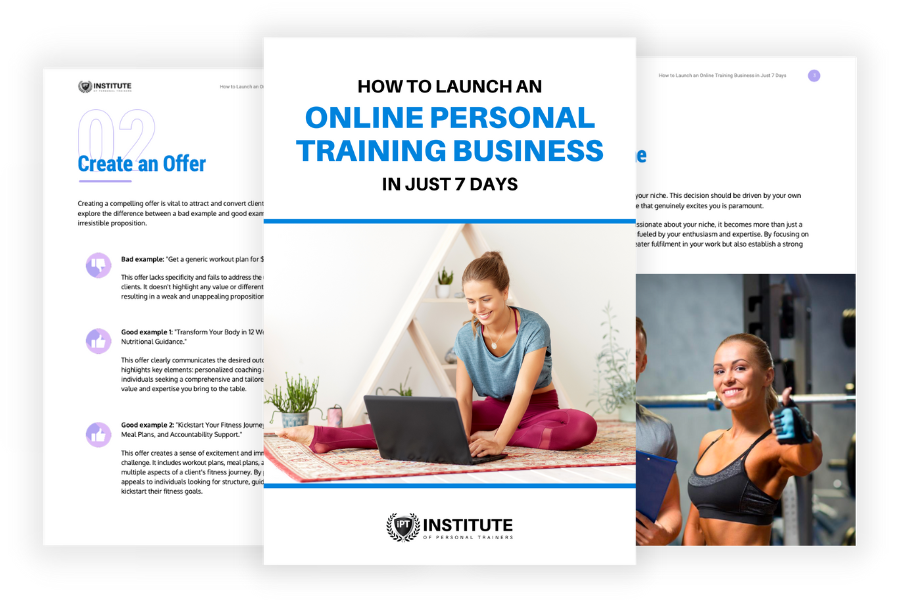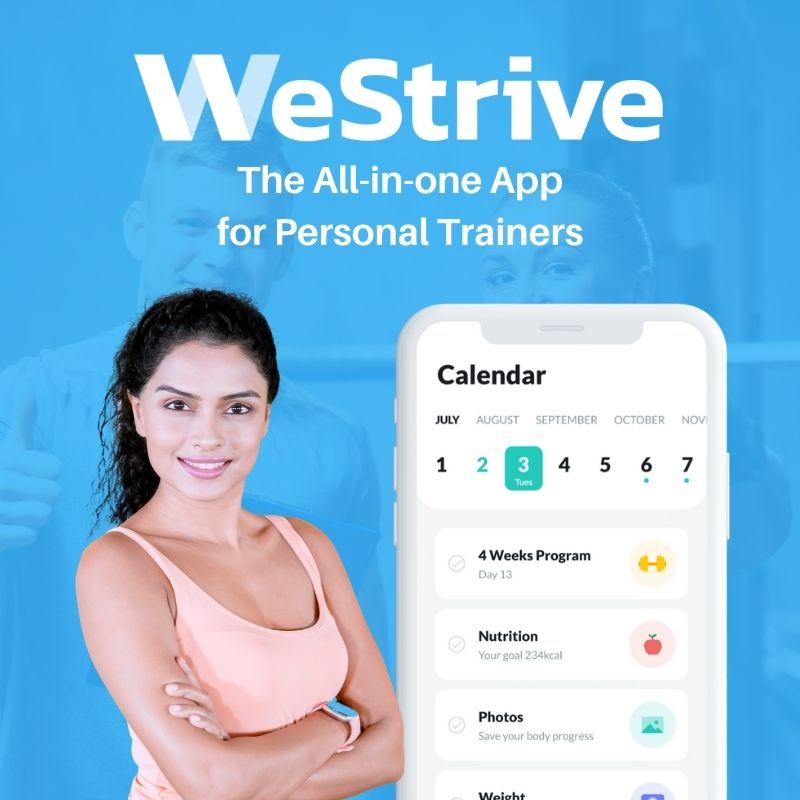|
FREE GUIDE: HOW TO LAUNCH AN ONLINE PERSONAL TRAINING BUSINESS
IN JUST 7 DAYS
✓ The new, better way of launching an online business
✓ The fastest way to create in irresistible offer ✓ A simple system to sell to clients who are interested |
|
In Canada, according to statistics provided by Statista, around 27% of Canadian adults were considered obese, with 33% of Canadians making fitness-related resolutions each year and aiming to prioritise their health. According to Newswire, more than half (53%) of Canadians say improving their overall quality of life is the primary motivation for pursuing a health and wellness resolution. Preventing health risks (45%), losing weight (42%) and increasing their energy (41%) ranked as other top reasons to exercise more and eat better. Personal Trainer Insurance in Other CountriesMany Canadians say they're willing to make lifestyle changes to achieve their fitness and nutrition goals. Nearly half (45%) say they would plan to change their eating habits by developing a healthy meal plan, while one in three (34%) say they would set a weight loss goal for themselves. Other Canadians are looking to become more active. Four in 10 (41%) would spend more time outdoors, while one in four (24%) say they'd find a friend to be active with. One in five Canadians (18%) say they would join a gym. Clearly, Canada is a great place to be a personal trainer. Getting insurance is essential if you’re working in the fitness industry in Canada. You are often the first professional someone might seek out for support with improving their health and extending their lives through fitness. In a population which is deconditioned, injuries are more likely and in the unfortunate case where someone might get hurt, having proper insurances in place can protect you, the commercial gym and the client. You can protect yourself with public liability insurance. In the event that one of your clients hurts themselves while training, and alleges that it’s your fault, this is the insurance that will protect you financially. It covers the claimant’s medical expenses, any lost earnings because of the injury, and any legal fees. It includes the equipment used in the course of a training session too. In making your choice, you may want to pay particular attention to the amount of “excess” you have to pay. That means that if you’re in a position where you have to actually make a claim on your insurance, the excess is the amount that you have to pay yourself. When your excess is very high, it makes your insurance premium much lower - but it might then make it hard for you to actually make a claim. Making sure your excess is affordable is an important consideration. As you’re considering the policies which are right for you, you might want to make particularly sure that the type of insurance cover needed is included in your policy. To help you with this, here’s a short guide to better understand the jargon. What types of cover are there?
Claims Made Vs. Occurrence Policies: What’s The Difference?Furthermore, in Canada, a distinction is made between Occurrence Policies and Claims-made Policies. A Claims-made Policy means that the insurance policy which is in force at the time a claim against you is made will pay for losses, regardless of when they occurred in the past. That is to say, the policy which is “live” at the time you need to use it will take responsibility for dealing with the claim against you - even if you had a different policy at the time the event that you’re being sued for happened. This assumes there is “no retroactive inception date restriction” on the policy. On a Claims-made Policy, usually, there’s no need to have a policy that lasts longer than about 7 years, as this is the length of time it would take for a case to go through the courts. With an “Occurrence” Based Policy, even though the policy may have expired, provided the policy was in force at the time that the bodily injury or property damage occurred, a claim can still be made against it. That is to say, you are able to make a claim on an insurance policy you’ve held in the past at the time when the event that you’re being sued for happened - even if that policy is old now, and has expired. It’s impossible to know ahead of time which will be the right choice for your individual circumstances, as the circumstances of each individual claim will be different. Insurance for Online Personal Training SessionsIncreasingly there is a demand for online “remote” personal training. With more people working unsociable hours or choosing a lifestyle which includes travel or shift working. Online personal training is becoming a more popular option as it offers the flexibility and accountability many clients need. While the risk of injury in a face to face session and group classes is something to be mindful of in your planning, the risk of injury during virtual sessions is higher. It’s harder to manage a client’s form and proper technique, it’s harder to estimate their rate of perceived exertion or heaviness of their breathing than it would be in person, and the added distraction of the virtual coaching dividing their attention to the phone or tablet they’re using might increase the risk of injury. All the more when the client is inexperienced, and you have never met them in person to assess their skill level. If you’re offering online remote training as a service, it is definitely worth checking that your insurance provider will cover this. Many Canadian companies do not cover this as standard in their personal trainer insurance and you may require a Commercial General Liability Policy. Many companies make a distinction between live, remote “zoom style” training that happens in real-time and online personal training where the trainer is not digitally present at the time of the client session. The options available from Canadian insurance companies vary a great deal, with exclusions in certain areas that you would expect to find included in most insurance policies. It’s worth noting before we get into the details offered by each company that paying close attention to what is excluded will be just as important as what the company includes. Personal Trainer InsurancePersonalTrainerInsurance.ca offers two types of insurance for people working within the health and fitness industry and is underwritten by the exceptionally stable Holman Insurance Brokers Ltd. The Occurance Form Option The first is a broad "Occurrence Form" which provides coverage throughout Canada in any facility. This policy is comprehensive and includes:
This policy starts from $190 annually, including Broker fee plus applicable tax. The Claims Made Form Option Their second option is aimed at Personal Trainers and Fitness Instructors who also offer complementary health therapies. It is best suited to health clubs, individual personal trainers and fitness instructors, sports trainers are included as standard, including dance instructors and martial arts instructors. This option is a "Claim Made Form" Professional Liability Policy. Features include:
This policy starts at an annual price of $235.00 + tax. Sport & Fitness CanadaSport & Fitness Canada offers coverage options in a number of health and fitness niches, including some which can be quite difficult to get cover for. Personal trainers and fitness instructors are included of course, but they also extend to coverage for: wellness centres, health clubs, Merrithew™ Pilates centres, martial arts, CrossFit™ Affiliates, dance studios, tanning salons, spas, sports teams and leagues and live events. They offer coverage for the following:
They offer a free, no-obligation quote based on your individual circumstances. They also offer a monthly payment plan option and don’t require the annual fee to be paid upfront. Hub InternationalHub International offers a 12-month insurance policy which becomes active on the day of purchase and is non-refundable if you cancel. This is one of the most limited insurance policies we look at with many exceptions and areas which are not covered. They make a distinction between Class 1 personal trainers and class two fitness professionals. Provincially Certified (Class 1) personal trainers are eligible to purchase insurance online from Hub if they are a Canadian resident over 18 years of age. Other fitness professionals (Other Certification (Class 2)) can purchase insurance online if they are certified by one of our approved certifying bodies and are a Canadian resident over 18 years of age. The coverage from Hub International is for liability only and provides protection when the personal trainer has behaved negligently and a third party has been injured. It doesn’t include injuries that the trainer may have - which for many trainer would rule out Hub International immediately - or the equipment that they used. It doesn’t include the financial damage that a person may experience due to the injury (through loss of earnings or private medical care) and explicitly states that it does not include cyber liability. This protects the trainer while they are in Canada - so although the company is named “Hub International” it doesn’t include international training. It does not extend to the coaches of professional athletes, carded amateur athletes, and activities for which the trainer is not certified by one of the insurance company’s approved certifying bodies. Make a note that if you conduct Zumba classes, you must purchase separate Dance Instructors Insurance unless you are certified through the eligible certifying bodies to instruct Zumba. Coverage with Hub International does not extend to work-related rehabilitation of any condition so be particularly careful that you are limiting your instruction around the injuries your clients have. They do not extend their coverage to tanning beds at all. The necessary paperwork in order to make a claim must be in place. That includes an annual PAR-Q and any necessary consultations with doctors where instructed to do so by the forms. If the doctor does need to be consulted, keep the written authorisation from them confirming the client is allowed to start training with you. The insurance will cover outdoor biking, provided your clients wear helmets at all times and reflective clothing if exercising in low light. Bikes should be well maintained, and have lights which are on in low light. The standard personal trainer insurance does not extend to studios (including home studios) or facilities the applicant owns, leases or rents on a long term basis. This requires separated premises related coverage and might be the element of this policy which rules it out for many trainers. The individual trainer is not covered in any abuse-related claim scenarios, which many other insurance providers do cover. This is probably one of the most limited insurance options available in Canada and prices are available on request via their website. NetsuranceNetsurance offers comprehensive, simple to understand coverage for a broad range of fitness professionals, including aquatic fitness, boot camp instructors, non-contact boxing such as boxercise, Crossfit coaches, dance and Zumba instructors, group fitness instructors, personal trainers, sports conditioning specialist, weight training coaches, wellness & nutrition specialists and yoga instructors. They provide an instant online quote, and upon purchase, you receive an electronic certificate proving that you’re covered from the next day. With many insurance providers offering same-day insurance, it’s worth noting that this is next day. Coverage is reasonably broad, including professional liability coverage against claims made by clients (sometimes called errors and omissions), commercial general liability to cover you against accidents like slips in the gym, business contents insurance which includes the equipment itself and insurance for the trainer themselves. You can pay annually, or monthly - with packages starting from $18 a month. ZensuranceZensurance offers a number of policy types for fitness professionals, including:
Policy costs are variable, based on how big your gym is, where you’re located, how much experience and education you have had as a trainer, and any previous claims on your insurance. But basic Professional Liability Insurance policy with a $15,000 limit is usually priced at around $250 annually, with more accurate quotes available on their website. K&K Insurance CanadaK&K provides insurance for personal trainers, and adult instructors for private or group instruction in the following fitness classes: aerobics, aquatic exercises, pilates and yoga, non-contact kickboxing for cardio, qigong, tai chi, GYROTONIC ® classes, dance and ZUMBA ®, spin classes, strength based training, boot camp instructors, children's fitness programs and stroller based fitness instructors. They expressly exclude acrobats, partner yoga instructors, the coaching of competitive athletics and certified athletics trainers. They do provide a general liability insurance policy which includes bodily injury & property damage, professional liability, products-completed operations, damage to premises which you rent, personal and advertising injury, medical expenses, and any legal liability. Confusingly, they exclude abuse, molestation, harassment, or sexual conduct (although do appear to cover the reimbursement of defence costs in this situation). They also exclude physicals and stress testing such as you might experience in the military or law enforcement training, amusement rides like slides, inflatables, bungees, climbing walls, or dunk tanks, physical therapy, massage or salon services, dietician services including weight control programmes or the sale of nutritional products. The categorisation of a climbing wall as an amusement ride might be particularly relevant for coaches of bouldering, rock climbing or parkour. Quotes are available online through their website. InfofitInsurance cover with Infofit includes full Professional Liability Insurance (errors and omissions insurance), sexual abuse expense reinbursement extension, tenant’s legal liabiity, employer’s liability, bodily injury and property damage (which includes mental and emotional distress), and injury to participants. This policy is valid throughout Canada and offers the option to be extended to include the USA. The offer a number of optional add ons to your policy, which include insuring equipment that you use away from the gym premises, interruptions to business, crime coverage, cyber crime such as data breaches, legal expenses - and particularly relevant - coverage for online training. They have two levels of coverage available. Option 1 with the annual premium of $175, which offers:
Option 5 with the annual premium of $305, which offers:
Choose the Best Insurance Policy for Your CircumstancesProbably more than in any other country we researched, the differences in policies between Canadian insurance providers were quite substantial so taking the time to have a clear understanding of what level of protection you need from your insurance provider will be especially important and it goes far beyond making sure the class you’re teaching is listed. You will need cover which is active in the locations that you need them, with a manageable “excess” should you ever have to pay it, will be key in making a good decision.
Regardless of which insurance provider will be right for you and your business, it’s important that you do get some form of insurance. Having a robust insurance policy in place is a must for any personal trainer, with many gyms insisting that they see insurance documents before you’re allowed to take classes or train clients on the gym floor. If you have a straight forward set of working circumstances, as a qualified trainer, working with people in one gym location, and not offering any martial arts, or outdoor sports, you can make a decision based on cost alone. But if you need something more flexible with regards to location, being unqualified or working with specific categories of athletes, or offering outdoors or unusual sports options as part of your training package, you may need to do a little more research. |
Our All In One Platform
Check out out all in one business & marketing platform for personal trainers!
WEBSITE BUILDER | FUNNELS |MEMBERSHIPS | SCHEDULING| EMAIL MARKETING| PAYMENTS| CRM | AI ASSISTANT | SURVEYS
Popular Articles
Trusted Partners
We work closely with some of the best service providers in the fitness industry.
Categories
All
|














